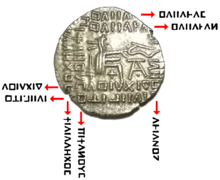

Greek inscriptions similar to "ΒΑΣΙΛΕΩΣ ΒΑΣΙΛΕΩΝ ΑΡΣΑΚΟΥ ΕΥΕΡΓΕΤΟΥ ΔΙΚΑΙΟΥ ΕΠΙΦΑΝΟΥΣ ΦΙΛΕΛΛΗΝΟΣ", meaning "[coin] of king of kings Arsaces, the benefactor ( Euergetes), the just ( Dikaios), the illustrious ( Epiphanes), friend of the Greeks ( Philhellen)", are found on coins of the Parthian Empire, starting from the reign of Artabanus I. [1] Some variations of this inscription exist.
The name Arsaces indicates the Arsacid dynasty and appears until the period of Phraates IV. [2]
Transliteration
BASILEOS BASILEON ARSAKOU EUERGETOU DIKAIOU EPIPHANOUS PHILHELLENOS. [3] [4] [5]
Literal translation
Some of the more frequent epithets appearing in the royal formula:
- ΒΑΣΙΛΕΩΣ ΒΑΣΙΛΕΩΝ = Of the King of kings
- ΜΕΓΑΛΟΥ = the Great (genitive form)
- ΑΡΣΑΚΟΥ = Arsaces (genitive form)
- ΕΥΕΡΓΕΤΟΥ = Euergetes, the Benefactor (genitive form)
- ΑΥΤΟΚΡΑΤΟΡΟΣ = Autokratōr, absolute ruler (genitive form)
- ΔΙΚΑΙΟΥ = Dikaios, the Just (genitive form)
- ΕΠΙΦΑΝΟΥΣ = Epiphanes, the Illustrious (genitive form)
- ΦΙΛΟΠΑΤΟΡΟΣ = Philopator, father-loving (genitive form)
- ΦΙΛΕΛΛΗΝΟΣ = Philhellene, the Friend of the Greeks (genitive form)
References
- ^ a b A catalogue of the Greek coins in the British Museum - "Catalogue of coins of Parthia", by Warwick William Wroth, 1903, p. 201, Oclc-id 3187578
- ^ Warwick William Wroth, 'On the Rearrangement of Parthian Coinage', N. C., 1900, pp. 181-202
- ^ "Drachm - Vologases III, Sellwood Type 78 - Ecbatana, Persia (ancient)". En.numista.com. Retrieved 21 August 2017.
- ^ "Drachm - Phraates IV, Sellwood Type 54, Persia (ancient)". En.numista.com. Retrieved 21 August 2017.
- ^ "Coin". British Museum. Retrieved 21 August 2017.